#ajitated art
Text

My piece for the first days of Funguary (Celestial, Mycena Subcyanocephala) and Fishuary (Shark)!
The shark I chose was the Blacktip Reef Shark 'cause they're super cute, and I wanted to give it "biblically accurate angel" vibes for 'celestial'. It ended up less 'mushroom' than intended, but hopefully the inspiration is still clear when you see what the actual fungus looks like!
#this took me multiple extra days to post cause i accidentally made the file too big and couldnt upload it 😭#funguary#fishuary#fishuary2024#funguary2024#ajitated art#shark#blacktip reef shark#mycena subcyanocephala#eyes#biblically accurate shark#digital art#original art#many eyes#extra eyes#celestial#im actually really proud of how this turned out#i worked super hard on it
118 notes
·
View notes
Text
A random assortment of memes with VTM characters.
The new prince of Seattle Ajit Rai meets his malk sheriff, his childe, and their ghoul circa 1996

Average night on the case for the best sheriff and scourge the camarilla has ever seen (the prince is getting a phone call right now)


Ft. Closeup of Harvey because his expression killed my fellow players
Attempted coup by the prince’s childe. Colorized 2014


Harvey darling, enemy of the ventrue, investigative journalist, and funniest man alive (the ventrue primogen is also a journalist.)
#vtm oc#vtm memes#vtm art#vtm malkavian#vtm ventrue#vampire: sleepless in seattle#mori.art.yee#Harvey darling#ajit rai#faolan#Red herring#malkom#vtm#vampire the masquerade#vampire: the masquerade#vamily#art#vampirethemasquerade#vtmb
61 notes
·
View notes
Text

Last thing of the year... scratch cards?
#artist on tumblr#scratch art#rainbow#battle craze#ajit (oc)#tsugumi (oc)#sherm (oc)#wallace (oc)#reaper (oc)#la justicia (oc)#my art
5 notes
·
View notes
Text
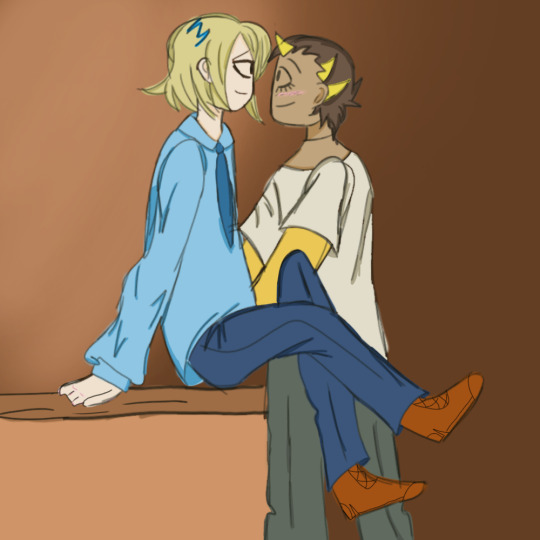
shunajit the sillies...turned worse than expected
#digital art#sketch#bad art#digital sketch#bakugan#badart#bakugan battle planet#ajit baa#shun kazami#shunajit#shun x ajit#studio d#bakuganships#bakugan reboot#bakugan fanart#sillyposting#shitpost#goofy ahh#so silly#bakugan battle brawlers#november#november 2023
3 notes
·
View notes
Text

Untitled Collage | Ajit Chauhan (b. 1981)
via Collé
2 notes
·
View notes
Text
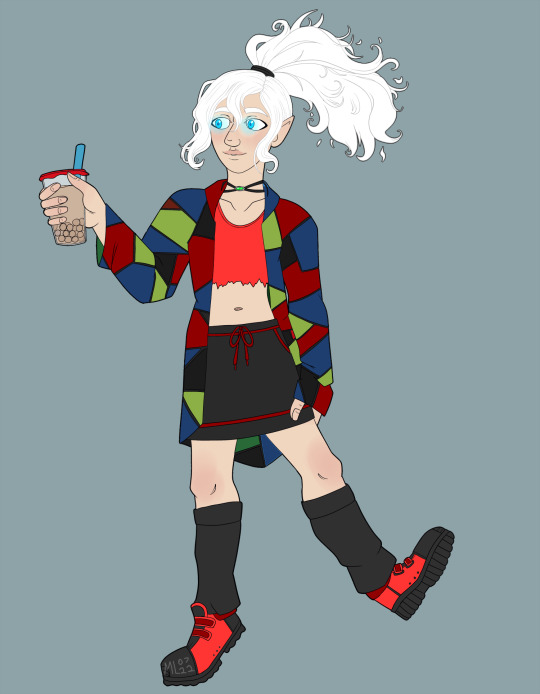
@ajitated also has a cute OC, though I had to consult a far more fashionable friend on color schemes to make the clothes idea for Fen here work lmao. They were fun to draw!
21 notes
·
View notes
Photo

Tantra Art its philosophy physics by Ajit Mookerjee - 1971
5 notes
·
View notes
Text
For An Anarchist Radio Relay League

A free zine about amateur radio for anarchists.
For an Anarchist Radio Relay League (0.24.1.1)
For an Anarchist Radio Relay League (0.24.1.1) -booklet
However, in a time when the United States government is fighting tooth and nail for the preservation of its own legitimacy while simultaneously eviscerating community services by way of privatization (Health Care, Postal Service, Public Land, Public schools, you name it), it is as important for the anti-authoritarian Working Class to learn about the science and art of radio communication as it is to learn how to grow food and shoot straight. (read "Factories, Fields, and the Firearms to Defend Them" by Hybachi LeMar )
In fact, in October of 2020, Ajit Pai's* FCC** ordered amateur access to the 3.5GHz band to be "sunset" (http://www.arrl.org/news/fcc-orders-amateur-access-to-3-5-ghz-band-to-sunset ) so that the frequency space can be sold to private companies to expand the new 5G mobile network. While this isn't exactly disastrous for anyone other than a specific sub-set of Hams***, it is par for the course for this early half of the 21st Century that the government would sell off public property to the highest bidder so that private companies can sell it back to "Consumers" and lock poor people out of access to something as ubiquitous as air or water. Sound familiar? (https://iaffaiorg.wordpress.com/2020/10/11/skills-for-revolutionary-survival-5-communications-equipment-for-rebels/)
701 notes
·
View notes
Text
Ectoberweek 2022

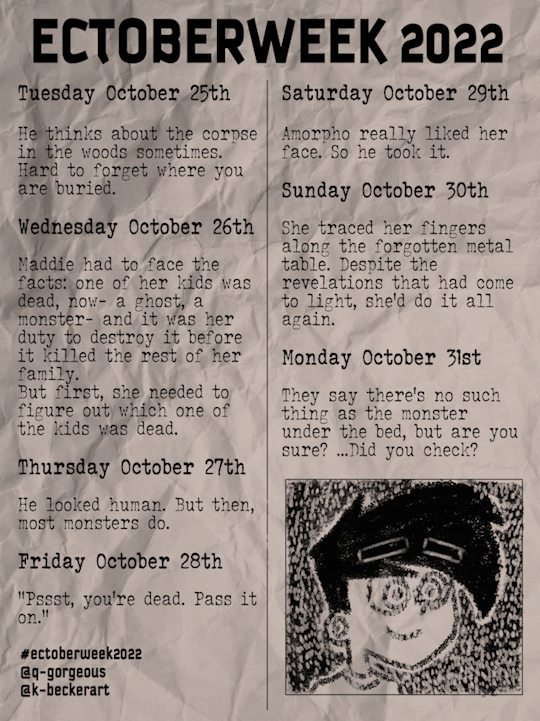
(Art credit to @q-gorgeous/@k-beckerart)
Tragedy struck Amity Park. The last week of the spooky season, seven one-word prompts are to be buried, and their obituaries printed and distributed across the city.
Each grave marks a story, a piece of art, a video, a poem, something that needs to be shown, needs to be told. And we ask you—writers, artists, and creatives alike—to be the ones to tell those stories.
For this year's Ectoberweek, you are provided a list of a one-word prompts and a list of two sentence horror stories. You can choose to base your creation off of one or both of these prompts each day.
All content directly related to the Danny Phantom cartoon is acceptable for this challenge. Ships, non-ships, crossovers, angst, fluff, classic art, digital art—so long as it relates to the show, how you choose to represent these prompts is entirely up to you.
Tag your work with #ectoberweek2022 so @ecto-american and I can see it. We are so excited to see the different art, fics, and other creative endeavors that people will take, and we sincerely hope you all have fun with the prompts this year!
Update: We now have a @ectoberweekofficial blog! Be sure to give it a follow!
Happy Halloween! 👻🎃
(prompts are listed out under the cut)
25. Forest
He thinks about the corpse in the woods sometimes. Hard to forget where you are buried
26. Six Feet
Maddie had to face the facts: one of her kids was dead, now—a ghost, a monster—and it was her duty to destroy it before it killed the rest of her family.
But first, she needed to figure out which one of the kids was dead.
27. Soul Shredder
He looked human. But then, most monsters do.
28. Scream
“Pssst, you’re dead. Pass it on.”
29. Lobotomy
Amorpho really liked her face. So he took it.
30. Shiver
She traced her fingers along the forgotten metal table. Despite the revelations that had come to light, she’d do it all again.
31. Folk Tales
They say there's no such thing as the monster under the bed, but are you sure? ...Did you check?
---
Be sure to check out the @ectoberhaunt Month Long Calendar if you want more spooky prompts this month!
If you'd like a nifty way to keep track of your completion of both Ectoberhaunt and Ectoberweek, here's a handy dandy spreadsheet made by @ajitated!
#danny phantom#ectoberweek2022#ectober#ectoberweek#calendar#phandom#dp events#writing event#art event
663 notes
·
View notes
Text
c3e65
Y'know, it only came up because I saw them in the art reel, but the Judicators do sound alarmingly like Cybermen.
"We... we spent every waking hour of every waking day trying to get back to you. And you came back with -- you have a boyfriend now? You had a little tryst? And you (Imogen) -- you have a new best friend, apparently? I thought about you every moment, and I thought you might've been dead... we didn't have downtime, we didn't have fun moments, we didn't go shopping, we didn't have threesomes -- we went to the middle of nowhere, we saved a fucked up town, and we almost had one of the Ruby Vanguard murder all of us. That was our fun time."
"We're not angry that you didn't suffer -- but it's going to take a while for us to recover." If you told me that, by episode 60, Ashton would be the Bells Hells' voice of reason, I'd laugh at you. But here we are.
Ashton says that he's feeling weirdly okay, Orym is frustrated and wants to move, and Laudna is... withdrawn? Angry? There are a lot of emotions going on, most of them conflicting.
They agree to split up for a day to go investigate different lines of inquiry -- Ashton and FCG want to visit Milo, Chetney wants to meet with Ajit Dyal. Afterwards, they plan to teleport to Zephrah to talk to Keyleth.
I feel like it needs to be restated that the temple of the Dawnfather in Hearthdale was built 30+ years ago because they were given permission to do so by wealthy landowners who bought a chunk of land and let them use it. They increased their presence in response to the solstice, yes, but in the end their prolonged presence there was the result of capitalism and wealth disparity.
We go first to the Krook House. Milo's workshop is in complete disarray -- most of their creations and projects have been disassembled because a lot of it just stopped working. "Wait, were your meds arcane?" ashton--
Ashton hands Milo a mystery note and a bag with some stuff in it. "How quickly can you do that?" "A day and a half." He hands over his hammer. "What are you plotting?" "I think I'm getting a real job. I think we're gonna save the world somehow, fuck it. I think we're gonna be some fuckin' heroes."
Ashton had a lot of time to think over the past few days. They thought about their life, everything that's happened. And they've decided that now is not the time to be worthless, now is not the time to be useless. He doesn't like having things to lose, but now he does, their time apart made him realize that, and he knows he can either risk losing them or he can go all-in with this new family.
They also call FCG out, gently, on their self-destructive tendencies. FCG agrees that if they start taking care of themselves more, the rest of the group will spend less time taking care of them (i.e. they won't have to stop them from sacrificing themselves at every turn), and that they -- between Frida and their newfound faith -- have found a reason to live.
Sometimes, caring for other people is the most punk thing you can do. Or whatever that one post said.
We go next to Imogen and Laudna. They go to visit Xhudanna, who has taken up painting.
"You don't need to listen in to hear my thoughts. I'll share them with you." "...can I kiss you?"
!!!!!!!!!!!!!
"I don't think you realize, you're such an anchor for me, and when you weren't here, I did such horrible things -- I'm worried I'm a bad person --" "I've heard everything inside you, Laudna, and you are not a bad person. I said you were my tether. Whatever you did, you can tell me." She recounts what happened with Bor'dor, that she was literally hanging on by a thread when she did it. His betrayal broke her, and she couldn't let him live. She says that she lost control, even though her inner monologue in that moment told her that she was holding on to control.
"He attacked you, first of all. Fuck him. And whatever happened with [Delilah]... we'll make it right again, okay?" "Can I be honest with you? There's part of me that thinks we shouldn't. We're about to face the greatest challenge of our lives." Delilah can make her stronger, and she thinks she can use Delilah.
Meanwhile, Imogen doesn't know whether she wants to get rid of the moon's tether. Power is tempting, alluring -- maybe it's their destiny to harness it, maybe it's to challenge and reject it, but only time will tell.
There's something happening in the marketplace. People gathered around in a circle. A familiar voice. "We were never meant to be bound by their laws. We were always meant to rise above them." A hologram-like image of Ludinus hovers above the fountain, speaking of finally rising past the imposed destiny, of no longer being the "beasts of burden" to the gods but the driving force of future and fate.
Guards rush through -- "fuck, another one!" -- and pull a silver disk from the water. When they smash it, the illusion fades. In the crowd, there's mostly fear and confusion, this is adding to their anxiety -- a handful seem to be absorbing the words, but the wardens are hastily dispersing the crowd.
Lastly, Chetney, Fearne, and Orym go to visit Ajit Dyal.
Leading up to the solstice, ships from the north docked in Jrusar before heading south, but after it, there has been a steady stream of new skyships and soldiers.
When they ask about rumors, Ajit says that the people of Jrusar are afraid more than anything. The Quorum calls for calm, but it's hard to ignore the soldiers, and the "big red sign of impending doom." There's an alliance between Issylran militaries, the leader of Ank'harel (J'man Sa'ord), the Clovis Concord, and the Stratos Throne, and all of them are sending forces to the Hellcatch Valley.
There are rumors that everything has been organized by the Stratos Throne and that this is the start of a second Apex War; meanwhile, doomsayers are saying that this is the start of a second Calamity.
As far as enchantments go, many of the automatons running the gondolas have broken down, and multiple prisoners who had been bound by magic have escaped. This is mostly why Jrusar's local guards are on high-alert. The leader of the Ivory Syndicate was among those who were broken out.
The temples have been more reluctant than usual to open their doors.
They ask Ajit to point them toward someone who might know something about Old MagicTM, and he immediately returns from inside the hall with Deremon, a very elderly man who once tutored Ajit.
Chetney pulls out the El Crusty Vest de Ludinus (TM) and shows it to the pair. "This is very peculiar; I have no idea."
Because Ajit didn't hear Ludinus during the solstice either, they gather that hearing that message was related to one's proximity to the leyline nexuses. People who were close to nexus points heard the voice and had a chance of being teleported, it seems, which also means that there is a leyline nexus over both Emon and wherever Deni$e found Dariax.
From the Dyal Hall, the trio starts to head toward the Smoulder Spire to visit the temple of the Matron of Ravens. On their way, a scent catches Chetney's nose -- the most savory meat pie he's ever smelled. To Orym and Fearne, it's more of a stale grain smell. Following it, it becomes an overwhelming hunger, a bestial drive toward the source, like fresh blood on a hunt. Chet makes a WIS save and fails with a 16, sprints toward the source -- in a dark alleyway, there's a short man in a hood, and he tosses a pouch to Chetney -- he catches it, it's a herby, medicinal texture, and the moment he bites it the figure throws a silver net over him.
"Stay away, miss, this is official business!" Fearne immediately throws a spell at him for 31 damage. "It's just business--" "This is my business."
god, the fact that they're going for lethal force immediately and asking zero questions of this normal, leather-clad, dwarven dude they know nothing about is so incredibly telling. especially for Orym, who specifically goes for a gut shot first before tripping him.
"This is a problematic, cursed beast, and I'm going to bring him in." "I mean, you're not wrong, but he's our problematic beast." There's a bounty on Chetney's head, and this guy is intent on bringing him in, but notably he is not making any damaging attacks against Orym (who's blocking his path) -- he's just trying to push past.
Fearne approaches, asks if she can give Chetney a kiss with a 28 persuasion check, and casts stoneskin on him. Interestingly enough, she ignores the 100gp material component for the spell -- so I wonder if Matt is being more lenient with valued components this campaign.
Mister runs up to Chetney and uses fiery teleportation for the first time, which gets him out of the net.
"Tuyen sends her regards." This guy was hired by Tuyen Otwana, the shopkeeper of Prism Emporium -- the shop that overcharged him for a wood chisel, that he subsequently attacked.
As Chetney casts invisibility, I am reminded that we still have no idea why Chetney has the Shadow-Touched feat, nor why Imogen has the Fey-Touched feat. (If there's a narrative reason for either, which I have to assume there is.)
The dwarf picks up the net and misty steps away.
The trio continues to the Smoulder Spire, and climbs almost to its apex. There, they find the temple to the Matron of Ravens, made of a darker material and cleaner than anything else here. The doors are closed, but not locked. Inside, there is a singular figure who opens their arms to the trio. Orym leads them in. "What brings you to the Duskmaven's sight this day, little one?"
"I'm sorry -- I don't have anyone else to turn to right now. I'm having major questions of my faith, and the changes I see above have me worried." "You are not alone." "I am no stranger to death, and I have heard tales of fate. But the things I'm seeing frighten me. What's happening?" "The skein is tangled; the threads are not. The fear that you feel is felt by all... there is much sewn (sown?) -- confusion, distraction. They are doing what we all are doing: what we must do to survive. And our fates are intertwined; if they, if she, can see this through, they will see us through it with them. [How do you know that?] Faith."
The priest can still feel the Matron's influence, but that presence is different than it was before the solstice. She feels a "human vulnerability," and finds it both strange and comforting to feel that in something so grand. "She was like us once, so perhaps she has that vulnerability uniquely." "Do you know what her name was?" "There are none who live that do."
"She may not have the answers you seek, as we are in both a period of mourning and a period of preparation." "How much time you think we've all got?" "Come drink of the waters with me."
The priest leads Orym -- to pulls Fearne along -- toward the interior waterfall. Along the way, they notice that some of the interior lights are dark. She fills a steel pan with water, and offers it to Orym to drink. He leans down, closes his eyes, and drinks the (very cold, but refreshing) water.
The cold spreads through him as he drinks -- not uncomfortable, but cold. Fearne, Chetney, and the priest do the same; as the priest kneels, Orym thinks that he "is just looking for answers," while Fearne thinks loudly that she is "just feeding the root."
"Away from the warming light of the sun--" Is the Matron being portrayed as the opposite of Pelor? Is that what's happening here?
They all spend an indeterminate amount of time kneeling by the water, disassociating, listening to the sound of the water, the cold, the still, and they wonder if this is a piece of death herself. They feel cold, content, at peace.
When they emerge from this state, Chetney is visible, and the priest is gone. They open the front door to a crimson sky, a familiar crater, a beam of noxious energy firing into the sky -- inside the beam they see an orb, hear a scream that doesn't stop, a scream that encompasses the entirety of Exandria and beyond --
and they see a flash of a white porcelain mask, they emerge from their trance state. The priest stands before them -- "we are in a period of mourning for one of our own." That's why the temple's torches are low, why their doors are closed: they are mourning Vax'ildan, the Champion of the Matron of Ravens.
"How do we help? How do we help in the fight? How do we turn the tide?" "Faith."
Orym stoops down, takes a bit of the water from the pool, and smears it across the front of his shield.
The Bells Hells reconvene and share their stories. Laudna is visibly much happier than when they last saw her. Imogen gives Ashton an orange.
Orym would've heard things about "the Champion of the Matron" just as he would've heard about historical figures, and he'd know that the Champion had a tie to Keyleth, but Keyleth herself never mentioned him in front of Orym.
the Bells Hells don't even knows who the gods are. They don't know the difference between the Change Bringer and the Moon Weaver. Fearne doesn't now that Morri isn't a god. They don't know the difference between the Dawnfather and the Matron of Ravens.
And suddenly, the Bells Hells are debating whether they're trying to save the gods or trying to save humanity. Orym argues that those two causes are the same thing, but Laudna disagrees, and FCG agrees to too far of an extent. Imogen conflates a signal from a god to worship. Laudna equates leveling a block of a city to intervention of the gods. \
Ashton -- the most sensible one here at the moment -- says that there's a lot of conjecture about things that just happen. "I watched my parents get ripped to bits in a maelstrom of gods-know-what, I got thrown into a desert and picked up by shitty people and thrown into a fucking orphanage where I stayed -- more or less, what you'd expect. I fought a lot, I made friends, we did what we fucking could, and I fell out a window and woke up in a pain that has never stopped. And there were little sections ot my life where I prayed, and I begged, anything to all of them, any of them, and the only time they've ever spoken to me was the one who tried to fucking kill me less than a week ago. So, I'm here to save us, I'm here to save the people who live here, hell, I've had one fucking word I spoke to a fucking pile of earth that was more responsive and made me feel better and more connected to anything in my fucking life, that grounded itself more -- and you know what? I'm all for faith. I'm not gonna pick a god, they can pick me, they can pray to me, they can choose me more than I ever did to them."
I lied, Orym is the most sensible one. "History is littered with their positive influence here; but none of you would suggest wiping out every living being on earth because some of them are shitty. Some of them have done good, and I think that thinking black-and-white is comforting -- but it's a little more nuanced than that."
"Why can't i have faith in you all? Faith in Exandria, faith in you all, faith in those that came before the gods? The eidolons, the earth, the titans?"
There's a lot going on here, and Team Issylra is (deliciously) misinterpreting the eidolons and the Dawnfather's temple. They all have different opinions, and they're all hung up on the definition of "faith" -- but in the end, they agree that regardless of whether the gods are worthy of saving, Ludinus needs to fucking die. And that's something I can get behind.
I've said it before and I'll say it again -- the discussion of whether or not the gods should exist, of whether the should or shouldn't exhibit their power over mortal-kind, of whether mortal faith gives them life and power, of whether they are in control of fate -- all of it doesn't fucking matter right now. Those questions are ones that can be asked once this is all over. Because the Bells Hells know that, objectively, Ludinus' plan is evil, he is not the one who should fill that power vacuum, he needs to be stopped.
Fearne attempts to scry on Ludinus. As her consciousness extends toward him, she drifts in a liminal space with nothing to tether to, and she realizes that she is unable to scry on him. He has and is attuned to an amulet of proof against detection and location, the same item that shielded Caleb from Trent's eyes.
FCG attempts to scry on Liliana Temult. He focuses on the coin and sees its metal first become strands of hair, then become darker metal; his vision pushes through the coin and into darkness, which turns to redness. He finds himself in the familiar red dust storm that fills almost all the space around him -- but he sees Liliana walking, her hair and coat billowing in the wind. To her left is Ludinus Da'leth, and on the horizon, there are shapes -- structures, buildings... in the sky, a round body of a faint bluish-green coloration -- Exandria looms just beyond the dust storm above." That's all they receive.
They're on the SURFACE OF THE FUCKING MOON, on the SURFACE of RUIDUS ITSELF
It was like they were walking through a street. There is no distinction between home and building here -- it's just a street.
Laudna and Chetney think that this city was on the continent that got scooped up to form Exandria.
FCG asks the Changebringer whether Exandria is round, and she responds, yes.
The Bells Hells deduce that they need to figure out "how to ride [the beam]," that they need to find out how to get to the surface of Ruidus. Spelljammer, here we come!
FCG casts identify on the harness. "The funnel goes to the base of the neck, between the shoulder blades. It is designed, though it does not currently function, to take the essence of some sort of magic and funnel it to some sort of place on the wearer's body -- between the shoulder blades, on the neck."
Orym assumes that the device was designed to prolong Ludinus' life, because fey creatures are generally more long-lived than Exandrians.
Ashton finally asks the question of where Ira and Xandis are.
By sunset, Milo has finished the modifications on Ashton's hammer -- they have installed the immovable rod into the handle. "I'm not entirely sure what the properties of this are, aside from the fact that it's very unique, there's a refractory aspect of the crystal itself." Inside the sack was some amount of the refractory crystal they took from the Verdant Tomb, and incorporating it into the hammer has had some...... unforeseen implications.
Orym tries Caleb's sending stone. "Caleb Widogast. Bells Hells here. We survived -- where are you? Do you know what happened out there?" There's static fuzz, and no response. There is no indicator on the Treshi scry ball, and the Drixlich sensor points toward Uthodurn.
Imogen tries to cast sending on Ira. "Ira? Can you hear me, is this working?" With a 53, a familiar static of the "arcane forces in the sky."
FCG scries on Ira, but he makes his save. Ira exists, he lives out there somewhere, but he made his save.
Fearne scries on Ira. She focuses, and connects to "the pulse of life around Exandria" -- Ira is deep within a clustered, red-dust storm, not among structures or others but alone, pushing through a maelstrom, a stronger storm than they've said, trudging through an intense red. A dark shape arrives and he presses up against it, leans against a massive, smoothed boulder, and ducks into an alcove. Outside the storm, he blinks, pushes dust out of the corner of his eyes. Another figure approaches -- thick, partially patchworkly-armored torso, a muscular humanoid figure of deep red skin, oddly textured face-- features sallow and smooth, one of the Reilora. They gesture, and Ira follows. Their features are different than the figure they saw Imogen summon, and different than the gith body Team Issylra found.
Using Orym's shield as a focus, Imogen invokes the staff, and teleports the Bells Hells to Zephrah. "It's... mid-day, a beautiful cloud-dappled sky. A beautiful horizon among brown and red stones, clusters of trees, pathways that lead through the mountains, grass fields, the mountains to the east... a precipice of a cliff that is woven through the peaks of these mountains, pastels, bridges and ledges that encompass the rustic homesteads that make up this community like the existence of this village is a gift from the land itself... a tall cherry tree sits on the precipice to your right."
#critical role#note watches c3#critical role spoilers#critical role campaign 3#critical role c3#critical role liveblog#long post
23 notes
·
View notes
Text
Resource Masterlist: Indian Art

Cheap/Free resources:
Wkipedia:
Wikipedia of Indian Art: I'll recommend reading the subtopics from bottom up; it seems more relevant that way!
Wikipedia of Indian Painting: once you go through this article you should further look into whichever style you like, and learn it in depth. It also has links to vernacular art.
Rasa: the classical theory of Indian aesthetics
From Archive.Org (maybe scholarly and/or illustrative. In case illustrations are not there, simply Google them for reference):
Stone Age Painting in India by Romert Brooks
The arts of India from prehistoric to modern times by Ajit Mookerji (If you have no idea about Indian arts, START HERE; it's a short book full of illustrations)
Rajput painting : romantic, divine and courtly art from India by Ahluwalia, Roda
Indian Painting by C Sivaramamurti
South Indian Paintings by C Sivaramamurti
Approach to nature in Indian art and thought by C Sivaramamurti
[There are many books on Indian art, architecture and sculpture by C Sivaramamurti on Archive.org. It's basically a goldmine.]
Kalighat : Indian popular painting, 1800-1930 by Balraj Khanna
Art of modern India by Balrak Khanna [Again, you can check out other titles by Khanna.]
Indian Textiles by John Gillow
Traditional Indian Textiles by John Gillow
South-Indian images of gods and goddesses by HK Sastri
Myths and symbols in Indian art and civilization by Heinrich Zimmer (no illustrations)
The art of Indian Asia, its mythology and transformations by Heinrich Zimmer (with illustrations)
History of Indian and Indonesian art by Ananda Coomaraswamy
A Concise History of Indian Art by Roy C Craven
Deccani Painting by Mark Zebrowski
Indian Folk Art by Heinz Mode; Subodh Chandra
Women of India by Otto Rothfeld (this isn't about art but has few informative illustrations on regional costumes of women)
Dress And Ornaments In Ancient India by Mohini Verma and Keya Bawa
Classical dances and costumes of India by Ambrose, Kay
Cultures and Costumes of India and Sri Lanka by Kilgallon, Conor (o course i had to see other books on costumes)
Studies In Indian Painting by DB Taraporevala
Five Thousand Years of Indian Art by Hermann Goetz
Indian Painiting by Philip Rawson
The Art of Tantra by Philip Rawson
MS Randhawa (different books on Punjabi paintings Basohli, Kangra, Guler and General Themes in Indian Painting)
The imperial image: paintings for the Mughal court by Beach, Milo Cleveland
Wonders of nature : Ustad Mansur at the Mughal court by Dāśa, Aśoka Kumāra
Imperial mughal painting by Welch, Stuart Cary
Painted delight : Indian paintings from Philadelphia collections
India : life, myth and art by Ram-Prasad, Chakravarthi
The heritage of Indian art by Agrawala, Vasudeva Sharana
The adventures of Rama : with illustrations from a sixteenth-century Mughal manuscript
Indian paintings from the Punjab Hills by WG Archer
Art in East and West by Rowland Benjamin
Stella Kramisch (An American art historian and curator who was a leading specialist on Indian art, including folk art, for most of the 20th century. Also a Padma Bhushan awardee.)
The transformation of nature in art by Coomaraswamy, Ananda K
Books available on Libgen:
Art Of Ancient India : Buddhist, Hindu, Jain by Huntington and Huntington
The New Cambridge History of India, Volume 1, Part 3: Mughal and Rajput Painting
Myths and Symbols in Indian Art and Civilization by Heinrich Zimmer
Four Centuries of Rajput Painting: Mewar, Marwar and Dhundhar Indian Miniatures from the Collection of Isabelle and Vicky Ducrot
Ajanta by Yazdani
The Aesthetic Experience Acording to Abhinavagupta
TheHeritageLab is a free website to connect you to cultural heritage through stories, public engagement programs, campaigns, and free-access content.
Also if you're in Delhi, do consider getting a membership of Indira Gandhi National Centre for the Arts (IGNCA) library.
Folk art:
Folk art is an entirely different area that deserve a post of its own. But i love them so here is a long list by Memeraki.com. You can Google each and then look more into what you like. This website also offers very cheap courses in traditional Indian arts by the hidden and disenfranchised masters themselves! It's doing a great work in giving them a platorm. I myself have taken the Mughal Miniature course here. You can consider it.
Illustrated Books:
Note: These are coffee table books with beautiful illustrations that you'd love to looks at.
The Night Life of Trees: In the belief of the Gond tribe, the lives of humans and trees are closely entwined. A visual ode to trees rendered by tribal artists from India, this handcrafted edition showcases three of the finest living Gond masters. THIS YOUTUBE LINK shows the making of the book. The channel also features other works of Gond art.
An Unknown Treasure in Rajasthan: The Bundi Wall-Paintings: This book celebrates the surviving wall-paintings at Bundi by presenting a stunning photographic survey
Painting In the Kangra Valley: Painting in the Kangra Valley is an attempt to survey the painting styles of Guler and Kangra, which flourished in the 18th and 19th centuries. The painting activity began with Kashmiri painters (...)
Indian Painting: The Lesser Known Traditions: India has an astonishingly rich variety of painting traditions. While miniature painting schools became virtually extinct with the decline of aristocratic patronage, a number of local vernacular idioms still survive and continue to develop.
Madhubani Art: Indian Art Series: Madhubani art's origin is believed to go back to the ancient era of the Ramayana, when the town was decorated by inhabitants of the region for the wedding of Lord Rama and Sita with elaborate wall paintings and murals (...) Primarily a significant socio-cultural engagement for the womenfolk of Bihar, this art was a welcome break from their daily drudgery.
Reflections on Mughal Art and Culture: Enter the splendid world of Mughal India and explore its rich aesthetic and cultural legacy through fresh insights offered by 13 eminent scholars.
Monsoon Feelings: A History of Emotions in the Rain: Through a series of evocative essays exploring rain-drenched worlds of poetry, songs, paintings, architecture, films, gardens, festivals, music and medicine, this lavishly illustrated collection examines the history of monsoon feelings in South Asia from the twelfth century to the present
Sita's Ramayana shifts the point of view of the Ramayana - the saga of a heroic war - to bring a woman's perspective to this timeless epic. Illustrated with Patua painting.
Adi Parva: Churning of the Ocean: a graphic novel that is a revisionist retelling of some of our oldest tales which have inspired and guided generations of people.
Ajit Mookerji, Sivaramamurti and Craven Roy's books are concise from where one can begin and then delve deeper into the subject of interest. Reading history and myths behind the work for context and listening to music from the given time/region alongside will make the exploration even more enjoyable!
#indian aesthetics#indian art#master post of indian art#desi#desi culture#desi aesthetic#indian dark academia#indian art history#indian art history books#indian art books
26 notes
·
View notes
Text


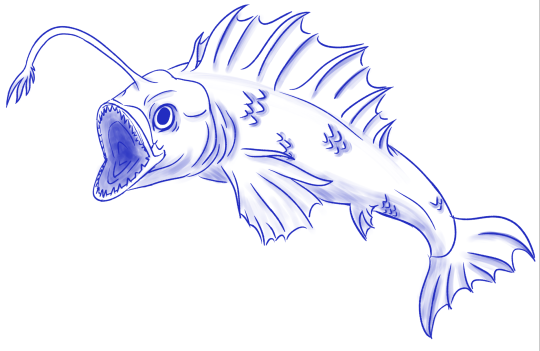
annddd more fish sketches, this time actually from this month! Woooo!
This time there's lumpfish, lobster, and a random fish monster thing I doodled~
#ajitated art#aj sketches#fish#fish sketches#original art#pencil sketches#digital sketches#creature design#fish monster#lumpfish#lobster#fish art
101 notes
·
View notes
Text
You can learn a lot about how a man was raised by how he plays an instrument.


Ajit Rai and Edmund Knight. Blood brothers and embraces of the dearly departed Justice Bucaddus the legionnaire.
#mori.art.yee#vampire: sleepless in seattle#vtm ventrue#vtm#vtm oc#vtm art#vtm ocs#vampirethemasquerade#vampire the masquerade#ajit rai#Ventrue#vamily#someone said they’re the emo and bimbo sibling and I’m still thinking about it#vtmb#art#vampire: the masquerade#oc art#digital art#Justice knight
50 notes
·
View notes
Text
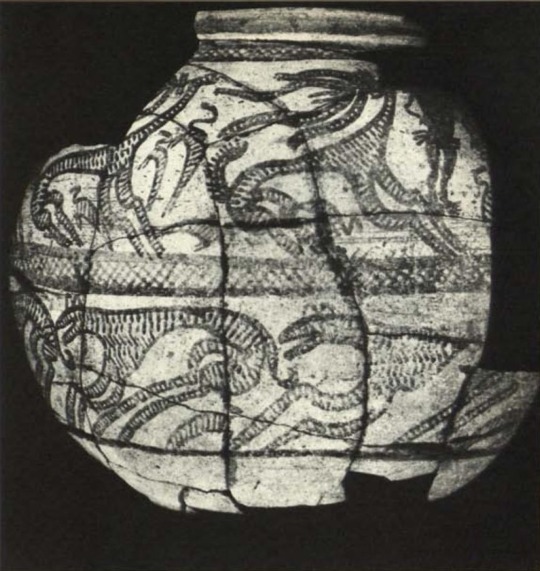
“Painted Pottery Aurangabad, Daimabad excavation, 38 cm high 2,000 в,c. / Coll. of Antiquities, Safdarjang With decoration consisting of two horizontal panels divided by a thick border of criss-crossed lines, this object is representative of prehistoric art in South India. Animals show a tendency to whirl-like mocement, which here is emphasized by the deer antlers (top row)”
From: “Arts of India” by Mookerjee, Ajit; 1966.
25 notes
·
View notes
Photo

Always wondered why this 2 mfs dont go to the same class as the awesome brawlers..it doesntt matter anyway
5 notes
·
View notes
Text
Robert Fraser reviews Tantra Exhibition, 1971 (transcription)
Robert Fraser’s review of The Hayward Gallery’s Tantra exhibition, September 30-Nov. 7, 1971. Published in Studio International, vol. 182 no. 939, Dec. 1971
Originally posted here by @ljblueteak

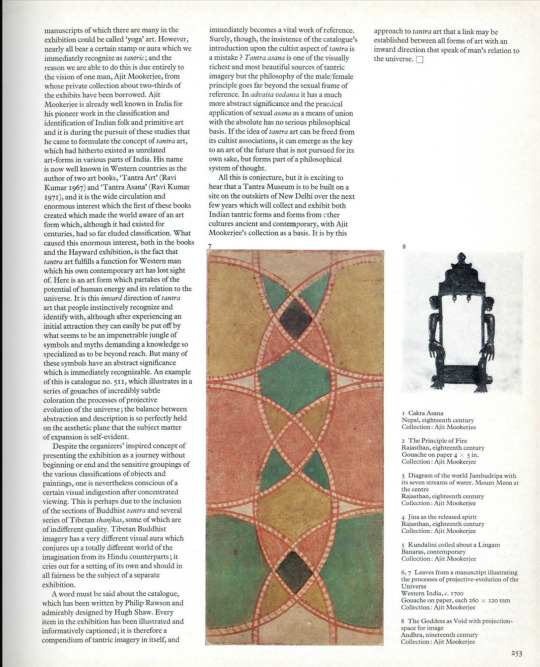
Transcription below the cut
The exhibition of Tantra on show at the Hayward Gallery from 30 September to 14 November has been an event which could be a catalyst to the formation of new conceptions as to the purpose and direction of the art of the future. In this instance I mean art taken as a global entity, not as something divided up into Western art or Eastern art. The first thing that might strike the view was that the show taken as a whole revealed a vision of a very ancient and systematic culture whose symbols and myths are alive right up to the present day; a Hindu or Buddhist could walk through the show and constantly be made aware of things which are a part of his own consciousness and personality. It is this aspect of tantra as a living sign-language and a living mythology which gives it special significance to us now. The basis of all tantric iconography is function; although tantra is based in the expansion of consciousness (Sanskrit root TAN expand TRA) its purpose is to provide and explain methods by which the expansion is to be achieved. There have been many different schools of thought on this subject and the reason for the seemingly baffling complexity of tantra is that it touches upon so many different levels and approaches to sadhana; philosophy, science and ritual are all involved in what was originally one system of thought based in vedanta. In recent centuries cults have grown up which have advocated specialized approaches, of which tantra asana is one; it is this one approach that has in the present day been identified most closely with tantra, and its over-emphasis has given tantra a notoriety which is based upon misconception of its full range. Nevertheless in this show all this enormous variety of imagery and symbol has been brought together under the umbrella of tantra art, as being visualizations of various methods towards the pursuit of sadhana and man's relation to the universe.
In style and content these exhibits differ widely. Many of them are what are known as Indian classical art, others are 'folk' or primitive forms; on the other hand the diagrams and manuscripts of which there are many in the exhibition could be called 'yoga' art. However, nearly all bear a certain stamp or aura which we immediately recognize as tantric; and the reason we are able to do this is due entirely to the vision of one man, Ajit Mookerjee, from whose private collection about two-thirds of the exhibits have been borrowed. Ajit Mookerjee is already well known in India for his pioneer work in the classification and identification of Indian folk and primitive art and it is during the pursuit of these studies that he came to formulate the concept of tantra art, which had hitherto existed as unrelated art-forms in various parts of India. His name is now well known in Western countries as the author of two art books, "Tantra Art' (Ravi Kumar 1967) and 'Tantra Asana' (Ravi Kumar1971), and it is the wide circulation and enormous interest which the first of these books created which made the world aware of an art form which, although it had existed for centuries, had so far eluded classification. What
caused this enormous interest, both in the books and the Hayward exhibition, is the fact that tantra art fulfills a function for Western man which his own contemporary art has lost sight of. Here is an art form which partakes of the potential of human energy and its relation to the universe. It is this inward direction of tantra art that people instinctively recognize and identify with, although after experiencing an initial attraction they can easily be put off by what seems to be an impenetrable jungle of symbols and myths demanding a knowledge so specialized as to be beyond reach. But many of these symbols have an abstract significance which is immediately recognizable. An example of this is catalogue no. 511, which illustrates in a series of gouaches of incredibly subtle coloration the processes of projective evolution of the universe; the balance between abstraction and description is so perfectly held on the aesthetic plane that the subject matter of expansion is self-evident.
Despite the organizers' inspired concept of presenting the exhibition as a journey without beginning or end and the sensitive groupings of the various classifications of objects and paintings, one is nevertheless conscious of a certain visual indigestion after concentrated viewing. This is perhaps due to the inclusion of the sections of Buddhist tantra and several series of Tibetan thanjkas, some of which are of indifferent quality. Tibetan Buddhist imagery has a very different visual aura which conjures up a totally different world of the imagination from its Hindu counterparts: it cries out for a setting of its own and should in all fairness be the subject of a separate exhibition.
A word must be said about the catalogue, which has been written by Philip Rawson and admirably designed by Hugh Shaw. Every item in the exhibition has been illustrated and informatively captioned; it is therefore a compendium of tantric imagery in itself, and immediately becomes a vital work of reference. Surely, though, the insistence of the catalogue's introduction upon the cultist aspect of tantra is a mistake? Tantra asana is one of the visually richest and most beautiful sources of tantric imagery but the philosophy of the male/female principle goes far beyond the sexual frame of reference. In advaita vedanta it has a much more abstract significance and the practical application of sexual asana as a means of union with the absolute has no serious philosophical basis. If the idea of tantra art can be freed from its cultist associations, it can emerge as the key to an art of the future that is not pursued for its own sake, but forms part of a philosophical system or thought.
All this is conjecture, but it is exciting to hear that a Tantra Museum is to be built on a site on the outskirts of New Delhi over the next few years which will collect and exhibit both Indian tantric forms and forms from other cultures ancient and contemporary, with Ajit Mookerjee's collection as a basis. It is by this approach to tantra art that a link may be established between all forms of art with an inward direction that speak of man's relation to the universe.
****
Interesting that Fraser was based in India at this time but familiar enough with a London show to be able to write a detailed review.
Vyner says: "Characteristically, though, his reappearances in London during the four or five years he was away shed little light on his actions and whereabouts other than conveying his increased enthusiasm for all things Indian."
2 notes
·
View notes